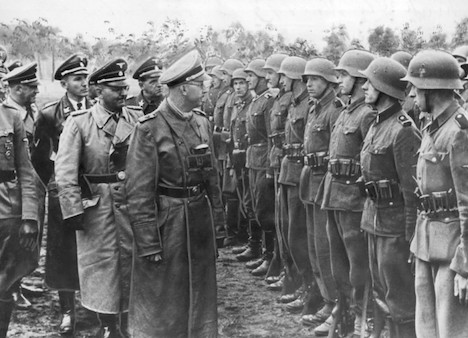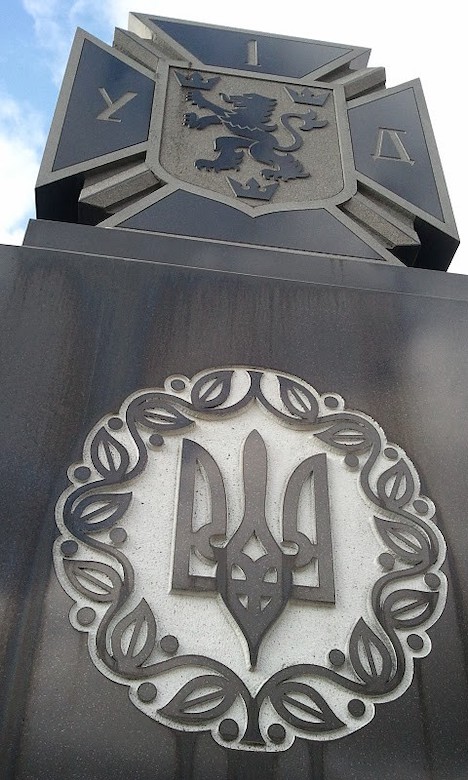Why is a monument commemorating a Nazi SS division still standing outside Toronto?
 Print This Print This
By Harrison Samphir | Canadian Dimension
from Canadian Dimension
Tuesday, Jul 28, 2020
The cenotaph at the St. Volodymyr Cemetery in Oakville honours members of the 14th Waffen Grenadier Division
 |
| Heinrich Himmler, centre, reviews troops of the Ukrainian 14th Waffen Grenadier Division of the SS, June 3, 1944. Photo courtesy the US Holocaust Memorial Museum. |
From a distance, the cenotaph at the St. Volodmyr Ukrainian Cemetery in Oakville, Ontario, just outside of Toronto, looks innocuous. Flanked by flagstaffs and set on a small, paved plateau, the monument is hardly out of the ordinary.
Yet few Canadians may be aware that this memorial commemorates a major battle fought by the Ukrainian Galician Division of the Waffen-SS against the Soviet Red Army during the Second World War. Fewer still may connect it with a more insidious form of far-right nationalism—one that quietly glorifies Nazi collaborators while giving credence to a far-right brand of historical revisionism.
Around June 21, the stone cenotaph was vandalized and spray-painted with the words “Nazi war monument.” Halton Regional Police initially began investigating the incident as a “hate-motivated” crime, but issued a statement on July 17 to clarify that the incident is now being treated as vandalism.
This was not the first time the monument has come under fire. In 2017, the Russian Embassy to Canada was accused of fomenting division by posting comments online that the memorial glorifies a Nazi history. In the context of Moscow’s then-recent annexation of Crimea, however, Canadian media immediately dismissed this criticism as part of a Russian “disinformation campaign.” Ihor Michalchyshyn, executive director and CEO of the Ukrainian Canadian Congress, denounced the comments as an attempt to “stir up controversy” and “obfuscate the [situation]” taking place in Europe at the time.
Since then, many others have urged a more serious reckoning with the monument, the sordid history of the Ukrainian independence movement, and the political allegiances of some of its forebears during the Second World War. The Ukrainian nationalist movement that first arose during the Tsarist era of the Russian Empire, culminating in defeat at the end of the Ukrainian-Soviet War in 1921, became split between moderates and the more radical Organization of Ukrainian Nationalists (OUN). This split was most apparent in the historical region of Galicia, which until the First World War was a part of Austria-Hungary, located in what is now western Ukraine.
The OUN was a far-right insurgency movement that fostered a sometimes-complicated relationship with the Nazis. The OUN and its two splinter groups—a conservative wing, the OUN-M, led by Andriy Melnyk, and an extremist ultranationalist faction, the OUN-B, headed up by Stepan Bandera—viewed Russia as the greatest enemy of Ukrainian nationhood, along with other neighbouring non-Soviet countries at the time such as Poland and Czechoslovakia.
The ‘Banderists’ in particular saw Jews as the “vanguard of Muscovite imperialism,” and were openly willing to commit barbarous crimes against them, as they believed it would lead to Ukraine’s independence from Russia and the Soviet Union. In 1941, under the OUN-B’s command, the Ukrainian People’s Militia spearheaded pogroms which led to the massacre of more than 6,000 Jews in Lviv.
The OUN also maintained informal control over many units of the auxiliary police, especially in Galicia. The local police helped to implement the Nazi genocide of Jews, Ukrainians, Russians, Byelorussians, and Poles by assisting in mass executions.
The Ukrainian Galician Division of the Waffen-SS—the military wing of the Schutzstaffel, Hitler’s foremost proprietor of terror—was formed in 1943 to support German forces on the Eastern Front following a series of Nazi defeats that had decisively turned the tide of war. Made up of Ukrainian volunteers, some of whom were drawn from the ranks of the OUN, the 13,000-man division was attached to the 13th German Army Corps and initially charged with defending an 80-kilometre-long frontline near Lviv. The Galician Division also assisted the Nazis in anti-resistance actions and reprisals. According to University of Ottawa professor and historian Ivan Katchanovski, the unit committed a massacre of more than 1,000 Polish civilians in Huta Peniatska in 1944. The town was razed to the ground and most of its inhabitants were murdered, including many young children.
In July 1944, facing an advancing Red Army, the Galician Division was encircled and largely destroyed by a much larger Soviet force. While it regrouped in August and joined other SS units in suppressing the anti-fascist Slovak National Uprising, the war would end less than a year later.
By 1950, many members of the OUN-B, the OUN-M, along with commanders and servicemen of military units including the Galician Division—all of whom collaborated to various degrees with Nazi Germany—were granted refuge in various Western countries. For its part, the Canadian government admitted between 1,200 and 2,000 veterans of the Galician Division, an official policy condemned by the Canadian Jewish Congress.
Despite the entire Waffen-SS being declared a “criminal organization” at the Nuremberg Trials, Canada was criticized for a “lax pursuit of accused war criminals.” This reputation was unwittingly reinforced by the findings of the 1985 Commission of Inquiry on War Criminals in Canada, often referred to as the Deschênes Commission, which concluded that charges of war crimes against the Galician Division have “never been substantiated.”
While military cooperation alone does not constitute outright allegiance to the hateful ideology of Nazism, the celebration of the Galician Division as a symbol of the fight for Ukrainian independence trivializes its role as an accomplice to one of the most violent and murderous regimes in history.
This glorification, embodied by the cenotaph at the St. Volodmyr Cemetery in Oakville, represents a troubling form of ethno-nationalism rooted, at least in part, in the ‘double genocide’ theory—an under-recognized form of historical revisionism equating the crimes of the Nazis and the Soviets. The theory’s ultimate purpose is to portray those who were accomplices to mass murder and war crimes as heroes who fought a repressive communist regime. This political doublethink whitewashes history and presents a dangerous moral equivalency between those who defeated fascism and those who allied with it. At worst, the double genocide theorists display a blithe disregard for the slain while participating in a form of competing victimology to justify past violence against Jews and other groups.
The last couple of months have seen a reckoning with historical monuments in the United States and around the world. Here in Canada, too, many have advocated for a closer examination of the historical deeds of some of our celebrated former leaders, demanding we confront their legacy in light of contemporary attitudes. Perhaps it is now time to break the silence around other uncomfortable parts of our past and demand the removal of the cenotaph at St. Volodmyr Cemetery and others like it elsewhere.
 |
| The cenotaph featuring the emblem of the 14th Waffen Grenadier Division of the SS (1st Galician). Photo from Wikimedia Commons. |
Source URL
|
 Print This Print This

|

